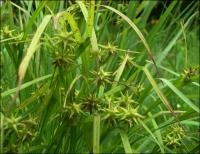Grasses, Sedges & Rushes
Showing 1–8 of 26 results
-
Achnatherum calamagrostis Silver spike grass Z 5-8
Elegant, tawny-silvery spikes sway in the breeze on this clumping grass from June all summer and fall.
Elegant, tawny-silvery spikes sway in the breeze on this clumping grass from June all summer and fall.
Size: 36" x 36"
Care: sun in moist well-drained soil
Native: Central & southern EuropeCollected before 1750. Calamagrostis is from Greek calamos for “reed” and agrostis for “grass.”
-
Bouteloua curtipendula Sideoats grama Z 4-8
Narrow, blue-green leaves tinged purple or red in fall when golden oat-like seeds hang down one side of each leaf, eye-catching.
Narrow, blue-green leaves tinged purple or red in fall when golden oat-like seeds hang down one side of each leaf, eye-catching.
Size: 2-3' x 1'
Care: Sun in well-drained to moist well-drained soil, drought tolerant
Native: most of US, incl. Wisconsin
Wildlife Value: nesting material for butterflies and bees; larval host for some Skipper butterflies,
Awards: state grass of TexasKiowa natives who had killed an enemy in battle with a lance wore this. Collected and described by French planthunter André Michaux (1786-1802) who scoured Eastern North America west to the Mississippi over 11 years.
-
Bouteloua gracilis Blue grama Z 4-9
One sided, horizontal, purple tinged spikelets looking like a row of eyelashes above the petite clump of thin grass blades, July-October
One sided, horizontal, purple tinged spikelets looking like a row of eyelashes above the petite clump of thin grass blades, July-October
Size: 2' x 12"
Care: sun in dry to moist well-drained soil
Native: all US except SE & NW, Wisconsin native
Wildlife Value: Host for caterpillars of several skipper butterflies. Deer resistant
Awards: Great Plants for Great Plains Grass of the Year 2008For the Navajo this was a “life medicine” and an antidote to an overdose of “life medicine.” Also used to cure sore throats and cuts – chew on the root and blow on the cut. Navajo girls carried it in the Squaw Dance. Hopi made baskets from this grass. Zuni made brooms & hairbrushes from it. Several tribes ate this & made bedding for their animals from this. Lakota children played a game using this grass: Most of the stems have two flowers on them. Children competed to see who could find the stems with three flowers, like finding a four-leaf clover. First collected for horticulture by Humboldt & Bonpland who scoured Latin America from 1799-1804.
-
Briza media Quaking grass, Pearl grass, Didder, Totter, Dillies Z 4-8
Elegant inflorescences with dangling oat-like spikelets
Elegant inflorescences with dangling oat-like spikelets in May. Use for cut arrangements, fresh or dried
Size: 30” x 10”
Care: full sun to part shade in any soil. Deer resistant.
Native: Eurasia.In cultivation since at least mid 1700’s.
-
Calamagrostis brachytricha Diamond grass, Feather reed grass Z 4-9
Extraordinary, voluptuous plumes with pink caste, September to November, much underused. One of internationally known garden designer Piet Oudolf’s 100 “MUST HAVE” plants, Gardens Illustrated 94 (2013)
Extraordinary, voluptuous plumes with pink caste, September to November, much underused. One of internationally known garden designer Piet Oudolf’s 100 “MUST HAVE” plants, Gardens Illustrated 94 (2013)
Size: 4' x 30"
Care: Full sun to part shade in moist to moist well-drained soil.
Native: East Asia
Awards: England’s Royal Horticultural Society Award of Merit & Great Plants for Great PlainsDescribed in 1854 in Synopsis Plantarum Glumacearum.
-
Calamagrostis x acutiflora”Karl Forester” Feather reed grass
Completely, reliably erect grass - winner perennial plant of year award 2001.
Completely, reliably erect grass – winner perennial plant of year award 2001.
Size: 3-5' x 2'
Care: sun to part shade in moist to moist well-drained soil. Cut back in late winter.
Awards: Perennial Plant Association Plant of the Year 2001This is a natural cross of Calamagrostis epigeos and Calamagrostis arundinacea, natives of Asia and Europe. German nurseryman Karl Forester’s (1874-1970) keen eye spotted this in the Hamburg Botanic Garden. He listed this in his nursery catalog in 1939. Under Nazi domination he risked it all by keeping Jewish friends & workers. After WW II his nursery was the only perennial supplier in East Germany. This grass sent from Denmark to the US in 1964.
-
Carex comosa Longhair sedge, Bristly sedge Z 4-10
Ornamental dangling bottle brush spikes from May to August
OUT OF STOCK
Ornamental dangling bottle brush spikes from May to August
Size: 2-4’ x 2’
Care: Sun to part shade in wet to moist soil
Native: all of sub-Arctic No. America except western intermountain states and provinces and except Alaska.
Wildlife Value: food for caterpillars of several butterflies. Seeds provide food for wetland birdsRhizomes stabilize shorelines while plants give ducks cover and the seeds provide food. Good rain garden plant.
-
Carex grayi Gray’s Sedge Z 3-8
Cool club-like maces at the ends of stems- June to October
Cool club-like maces at the ends of stems- June to October
Size: 30" x 24"
Care: Full sun to part shade in moist or moist well-drained soil
Native: Vermont west to Wisconsin, south to Georgia and Missouri
Awards: Great Plants for Great Plains1st described in Vol VII of Transactions of Linnaean Society c. 1798. Botanists named and renamed it finally settling on Carex grayi to honor botanist Asa Gray (1810-1888).








